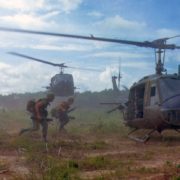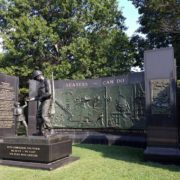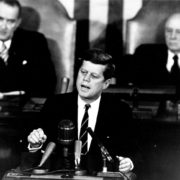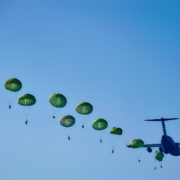How did the Vietnam War start?
What is the Vietnam War? The Vietnam War is a military conflict between the North Vietnamese and US. Although the confrontation was primarily military in nature, the American involvement in Vietnam can be explained by the growing concerns over an expanding ideological threat (i.e. communism). As such, the Vietnam War can be interpreted as a Cold War proxy war.
Topic of Study [For H2 and H1 History Students]: Paper 1: Understanding the Cold War (1945-1991) Section A: Source-based Case Study Theme I Chapter 2: A World Divided by the Cold War – Manifestations of the global Cold War: Vietnam War (1955-75)
In the following sections, we will examine how the Vietnam War began, intensified and ended.1. Military Retaliation [Tonkin Gulf incident, Aug 1964] The shift in US stance for greater involvement in the Vietnam War can be observed by the significant turn of events, such as the Tonkin Gulf incident. In August 1964, the US warships [Maddox] were victims of two torpedo attacks by North Vietnam. The American warships were escorting South Vietnamese marine forces in international waters. In response to the confrontational incident, US President Lyndon Johnson vowed to resort retaliate through military action. Eventually, Johnson obtained a clear mandate from the US Congress, leading to the passing of the Tonkin Gulf Resolution.
This Resolution granted Johnson the authorization for the use of military force in Vietnam, without having to undertake a formal declaration of war. Therefore, it is clear that US had stepped up its involvement in the Vietnam War, which was intensified by the extensive use of land and air attacks.2. Mounting domestic pressure for disengagement [Tet Offensive, Jan 1968] Following persistent efforts by the US to achieve victory in the military confrontation against North Vietnam, such as the Operation Rolling Thunder [Jan 1965], the Vietcong conducted a massive military campaign that took the US by surprise. During the Vietnamese Tet holiday, the Vietcong attacked major cities in South Vietnam and captured the Saigon Embassy. They were close to complete military victory.
Although it appeared as if the Vietcong had won, it was a devastating failure for them, as seen by the loss of 40,000 troops and the unsuccessful push to cause the collapse of the Saigon regime. More importantly, the Tet Offensive dealt a severe blow to US as the media reports revealed to the American public that US was far from winning the war. Initially, throughout the military campaign, Lyndon had assured the Americans that they were making significant progress and would eventually be victorious. As such, this revelation sparked widespread outrage, resulting in the rise of anti-war protests and demonstrations. As Lyndon’s approval ratings plummeted, he announced a major change in military stance to stop the aerial bombings in North Vietnam and promised to restore peace in Vietnam.3. Escalation of anti-war protests [My Lai Massacre, Mar 1968] After Richard Nixon won the presidential elections, he declared a new foreign policy stance, known as ‘Vietnamization’, which involved the withdrawal of American troops and provision of military training and support to South Vietnam in order to gain control of the war. However, his well-intended efforts were marred by a horrific and inhumane incident, known as the My Lai Massacre.
In March 1968, US troops killed more than 500 unarmed civilians in the My Lai village. One of the army commanders, Lieutenant William Calley, commanded his soldiers to fire at the innocent civilians. Eventually, the brutal massacre was revealed to the American public, fueling greater anti-war sentiment. The negative perceptions towards the American involvement in the Vietnam War manifested in the form of numerous demonstrations on the streets of America. This development culminated in the largest anti-war demonstration in November 1969. Over time, US troops were gradually withdrawn in the subsequent years.4. Outcome of the Vietnam War [Paris Peace Accords, Jan 1973] As part of Nixon’s ‘Vietnamization’ foreign policy that sought to end American involvement in the war, he also oversaw the peace-making process, as exemplified by the Paris Peace Accords. In January 1973, a peace treaty was signed by North Vietnam, South Vietnam and the US, to mark the end of the Vietnam War officially.
However, the Paris Peace Accords only provided a temporary ceasefire. On 30 April 1975, the North Vietnamese troops captured Saigon – the capital of South Vietnam, which was later renamed Ho Chi Minh City. The ‘fall of Saigon’ signalled the end of the Vietnam War as the country was unified under communist rule.What’s Next? After you have examined the key events that shaped the Vietnam War, it is important to reinforce your comprehension of historical issues by considering the following questions: – Why was the Vietnam War considered a Cold War conflict? – In comparison to the Korean War and Cuban Missile Crisis, how did the Vietnam War affect the internationalization of the Cold War? [to be discussed in class]
The H2 and H1 History Tuition feature online discussion and writing practices to enhance your knowledge application skills. Get useful study notes and clarify your doubts on the subject with the tutor. You can also follow our Telegram Channel to get useful updates. We have other JC tuition classes, such as JC Math Tuition and JC Chemistry Tuition. For Secondary Tuition, we provide Secondary English Tuition, Secondary Math tuition, Secondary Chemistry Tuition, Social Studies Tuition, Geography, History Tuition and Secondary Economics Tuition. For Primary Tuition, we have Primary English, Math and Science Tuition. Call 9658 5789 to find out more.




